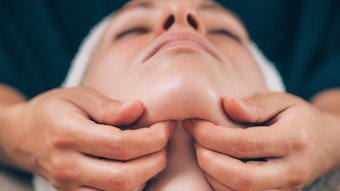
Although the progression of rosacea can vary substantially from one individual to another, flushing and persistent redness are by far the most common early signs of the disorder, according to a new survey conducted by the National Rosacea Society.
In the survey of 1,072 rosacea patients on the order of appearance of rosacea signs and symptoms, 31% said that flushing was the first symptom they experienced, and 63% said it was the second. Meanwhile, 24% reported that persistent redness was their first sign of rosacea, while it was named second by 34% and third by 39%.
“Rosacea goes undiagnosed in so many people because the most common initial symptoms—flushing and persistent redness—are often overlooked or mistaken for something else, such as sunburn,” said John Wolf, MD, chairman of dermatology at Baylor University. “Very often, patients are already experiencing multiple signs of rosacea before they seek medical help.”
While nearly 43% of the survey respondents said more than a year elapsed between the time they experienced their first rosacea symptom and their most recent, for most this happened more quickly. Thirty-eight percent said the interval was only a few months and 20% said it was about a year.
Beyond flushing and redness, other signs and symptoms most commonly appeared in the following order: bumps (third, 30%, or fourth, 24%), pimples (third, 28%, or fourth, 20%), visible blood vessels (third, 17%, or fourth, 28%), burning or stinging (third, 14%, or fourth, 26%), dry appearance (fourth, 18%, or fifth, 21%), raised red patches (fourth, 16%, or fifth, 14%) and swelling (fifth, 15%, sixth, 12%, or seventh, 13%).
Although eye irritation was rarely the first sign of rosacea, it was reported as second by 14% and as third by 10%, fourth by 19% and fifth by 19% of the patients.
Survey respondents tended to be well into adulthood before the first sign of rosacea appeared. Twenty-five percent said they were in their 30s, 22% were in their 40s and 25% reported they were over 50. Seventeenpercent were in their 20s and 11% were under 20.
Rosacea often begins as a flushing or redness on the cheeks, nose, chin or forehead that may come and go. Over time, the redness tends to become ruddier and more persistent, and small blood vessels may appear. Without treatment, bumps and pimples often develop, and in severe cases the nose may become swollen from excess tissue. Burning and stinging are common, and in many patients, the eyes are also affected, feeling irritated and appearing watery or bloodshot.
“As awareness of rosacea and its early signs and symptoms increases, early diagnosis and treatment should become more of the norm,” Wolf said. “Patients will be better able to manage their disorder once they know what it is and receive proper therapy and daily care.”
He noted that more than 77% of the survey respondents reported medical therapy had reduced the signs and symptoms of their condition.
About the National Rosacea Society
The National Rosacea Society is the world's largest organization dedicated to improving the lives of the many millions of Americans who suffer from this widespread but poorly understood disorder. Its mission is to raise awareness of rosacea, provide public health information on the disorder and support medical research that may lead to improvements in its management, prevention and potential cure. Comprehensive information and materials on rosacea are available on the NRS website at rosacea.org.
Follow the National Rosacea Society on Facebook, Twitter (@Rosaceaorg) or Pinterest for up-to-date information and tips on rosacea. Information may also be obtained by writing the National Rosacea Society, 196 James Street, Barrington, Illinois 60010; via email at [email protected]; or by calling its toll-free number at 1-888-NO-BLUSH.










